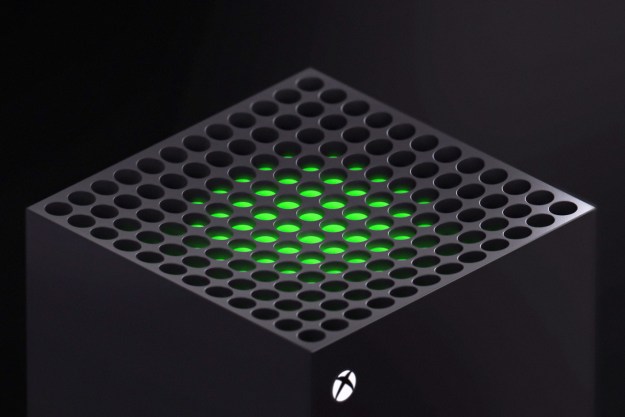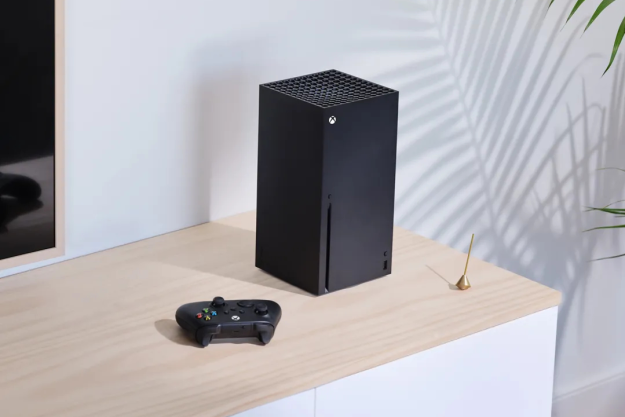
“Though it can't nearly deliver on Bethesda's intergalactic ambitions, Starfield is an impressive space RPG filled with impactful decisions.”
- Strong sidequests
- Impactful choices
- Impressive scope
- Beautiful space landscapes
- Great ship and outpost customization
- Flat main story and characters
- Dull exploration
- Disappointing flight
- Stability issues
For the wide-eyed members of Constellation, nothing is out of reach.
The exploration group at the heart of Starfield, Bethesda’s massive sci-fi RPG, seeks to answer the universe’s greatest mysteries, no matter how unknowable they may seem. It’s a romantic goal — one that’s inherently unfulfilling. In a constantly expanding universe, there’s no end to what we can discover. There’s always another planet to explore, an element to unearth, profound questions to be answered.
In some way, Constellation is the perfect stand-in for Bethesda Game Studios, the ambitious developer behind Starfield. The studio has always dreamed big, creating massive titles like The Elder Scrolls V: Skyrim that push the limits of what’s possible in video games. Starfield takes that philosophy to a more awe-inspiring scale, looking to capture the boundless wonders of our universe in an artistic medium that’s often defined by its technical limitations. It’s a sublime feat, but one that finds Bethesda facing the same bittersweet truth that Constellation’s intrepid explorers grapple with: those who seek the farthest stars will forever float in space.
Starfield isn’t the generation-defining video game that overeager fans might be expecting; it’s a fairly typical, though impressively constructed Bethesda RPG where depth and stability often come at the expense of scope. The surprisingly limited base adventure isn’t so much the draw here, though. The enormous intergalactic playground feels custom-made for modders who want to explore the infinite possibilities of space just as much as Constellation and Bethesda itself.
Video review
Humanity, expanded
Starfield begins with a sci-fi mystery: A simple mining operation turns into something much bigger when the player character discovers a mysterious metal artifact. After getting a bewildering vision of the universe, they take the object to Constellation, an explorer group that’s intent on learning what it all means. That inciting incident kicks off a surprisingly unimaginative main quest, as players travel the universe in search of metallic doohickeys. Even with some extra outer space intrigue, the core campaign rarely rises above a ponderous meditation on vague sci-fi concepts it can’t possibly hope to say anything profound about.
Starfield is a celebration of human beings and all their complicated problems …
It doesn’t help that I’m joined by a crew of boilerplate RPG companions that I struggle to connect with. Constellation members, like the always peppy Barrett or the aloof Andreja, feel like stock archetypes created to recite different philosophies on life, the universe, and everything else. These characters could have brought intimacy back into a heady outer space story, but there’s a notable lack of humanity in my more personal conversations with companions.
Though its main questline is lacking, Starfield makes up for that in its wider worldbuilding and side content. During my playthrough, I’d become engrossed in a storyline that had me working for Ryujin Industries, the universe’s most dominant megacorporation. Rather than exploring alien worlds or getting into shootouts with ruthless Spacers, I spent hours completing petty acts of retribution against rival companies. I stole business secrets and sabotaged presentations in a corporate warfare story that almost reads like a satirical jab at Bethesda’s parent company, Microsoft.
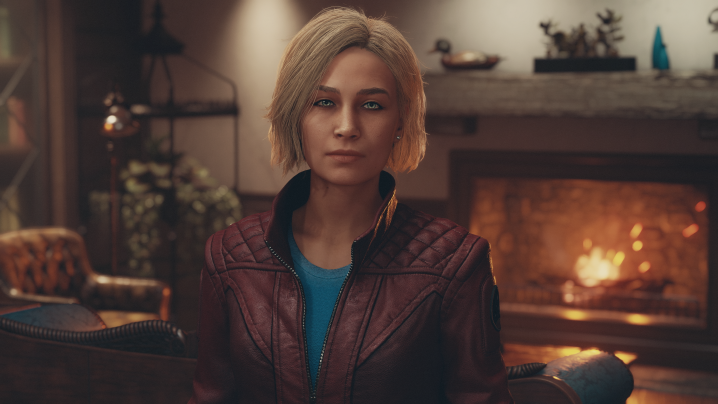
Human drama like that drives home Starfield’s strongest observation. Humanity is given an incredible gift as it’s able to rebuild itself among the stars. Rather than using that infinite potential for good, some humans only manage to expand their flaws on a galactic scale, like a houseplant repotted into a bigger home. It’s a bit of biting cultural commentary, but there’s sincerity in it too. Starfield is a celebration of human beings and all their complicated problems that’s in genuine awe of how we bring so much color and life to the infinite blackness.
That point is best explored in an easy to miss sidequest nestled deeply in the void of some distant galaxy. During my travels, I accidentally stumble on a ship under the control of a rogue AI. At first, I assume I’m in for a fairly generic 2001: A Space Odyssey send-up about an evil machine. Instead, I have a heart-to-heart conversation with the bot, teaching it what being human truly means. Doing so inadvertently gives it anxiety. It melts down in a bittersweet moment, seemingly grateful that I’ve taught it to be a complete mess, just like me.
RPG chops
Though its intergalactic setup leaves a lot of room for gameplay creativity, Bethesda sticks to its fundamentals for the most part. Most of my time is spent either chatting with NPCs or looting hundreds of items until I’m encumbered (an always annoying status condition that can result in physical damage here). It’s easy to be disappointed at first considering how wide its world seems. A good chunk of quests all take place in a small handful of hub cities. Some have me fast traveling to some far-off planet so I can press a single button and trek back to the NPC who gave me the task. Only the story’s last few quests offer anything in the way of memorable set pieces.
Those who don’t already dig the format of Bethesda’s games won’t find much new to love here, but the studio’s RPG expertise is on full display. That’s thanks to a powerful character-building system that lets players pick starting traits that have a clear impact on their journey. I built my hero out as a sort of Han Solo type, a street smart sweet-talker who could bargain or argue their way out of any situation. My persuasion-heavy build came in handy when I reached Neon, a dense pleasure city that I just so happened to grow up in. Any Neon-related quest was a snap to complete, as my street knowledge gave me authority with a wealth of characters. My ongoing spacefaring story very much feels like my own.

When I’m not chatting with NPCs, there’s a good chance I’ve found myself in some kind of gunfight. Like The Witcher 3: Wild Hunt or Cyberpunk 2077, combat is more of a necessity than a highlight. Gunplay and melee attacks largely feel weightless and devoid of impact, but there’s a wealth of weapons to goof around with. My go-to was a flaming pistol I negotiated off of a wanted woman as I helped fake her death and avoid bounty hunters. It ended up being a worthwhile reward for a skippable sidequest.
While combat isn’t especially exciting, there are some extra twists that help it stand out. Extra skill perks and unlockable abilities deepen the combat, even bringing a hint of Dishonored to the game. It’s a nice way to add a little extra customization to a standard shooting system, working some unexpected surprises into an otherwise traditional shooter.
I’m oddly restricted in what I can actually do.
It’s all functional, but the emphasis on action can feel hollow too. With such an enormous game that spans galaxies, it’s a little discouraging that so much of my time is spent shooting humans and a very small handful of robots. When I’m off exploring distant planets, it’s largely so I can find new weapons or materials that I can transform into gun mods. While the world around me feels infinite, I’m oddly restricted in what I can actually do. Even its “research” aspect feels half-hearted, as there’s little incentive for scanning alien creatures and plants (not even so much as a codex to collect research in).
As immersed as I am, I’m always yearning for a greater purpose in Starfield. Surely there has to be more to this life than scavenging and killing! It’s an area where I can feel the limitations of human thinking — or at least the limits of a bankable, big-budget video game. Perhaps it’s a self-reflexive gag. Just as it’s comical to see Ryujin Industries squander the gift of space travel with its corporate warfare, maybe there’s some inadvertent satire in the fact that the most ambitious, adventurous game ever built is still a narrow-minded shooter.
A universe of potential
Starfield approaches a more meaningful gameplay experience in its optional systems and exploration, though that comes with its own limitations. Its most impressive feat is the fact that it includes over 1,000 fully explorable planets. That’s an undeniable technical feat, as each one has its own look, gravity, resources, alien inhabitants, and explorable points of interest like mining sites and caves. I’m astonished the first time I land on a random planet’s moon and start wandering, only to discover an enormous frozen research lab filled with loot and logs explaining what went wrong. Moments like that will have players hunting the universe and sharing discoveries for years to come.
It all seems a little too good to be true — and it is at times. Planets are vast, but largely empty. I mostly find myself walking across miles of empty space, stopping to mine for an occasional resource or scan an alien between larger points of interest. And while I was excited the first time I found a massive underground structure on a random planet, it wasn’t long until a poorly hidden magic trick revealed itself. A handful of assets and locations are heavily reused, randomly dotting planets with little rhyme or reason. It doesn’t just reuse the occasional building, either. I came across the same identical cave structure, item placement and all, three times across totally unlinked planets. The more I encounter moments like that, the more painfully aware I am of how difficult it is to distill the beautiful complexities of the entire universe into a series of mechanical processes.
Bethesda presents players with an astonishingly massive expanse and invites them to poke and prod …
That limitation is at its most unfortunate in Starfield’s most disappointing aspect: flight. In its most aspirational move, Starfield allows players to build their own spaceship, travel the stars, and engage in the occasional dogfight. The reality of that system isn’t as thrilling as it sounds. When flying, players are essentially dropped into a glorified skybox where they can float in front of a distant planet and occasionally pass by some rocks or floating debris. It’s about as deep as hovering in orbit during a Destiny 2 loading screen. It doesn’t really seem like Bethesda wants players to engage with it much either; it’s largely an underexplored middle man between fast traveling to a galaxy and landing on a planet.
Poor ship combat doesn’t help matters. Battles simply toss a few spaceships into the sky and have players plinking away at them with lasers until they blow up. An unlockable targeting system makes proceedings a little more engaging, taking cues from Fallout’s VATS system, but battles are largely a repetitive hassle. It’s part of a recurring theme in Starfield’s myriad of ideas; There’s a wealth of systems to play around with, but few have depth. It often feels like the goal was putting as much content into the game as possible instead of sharpening a few hero mechanics.
What’s far more successful is Starfield’s customization potential, which feels like it’ll truly inspire players. Outpost building acts as a strong creative tool, as players can easily establish complex bases on any planet and assign crewmembers to run them. That creates a stronger incentive to explore planets in search of valuable resources that can be used to build bases. Starfield offers a similarly powerful tool in its spaceship building, giving players a great way to express themselves through creation — though it’s a shame that actually flying that ship is such a drag.
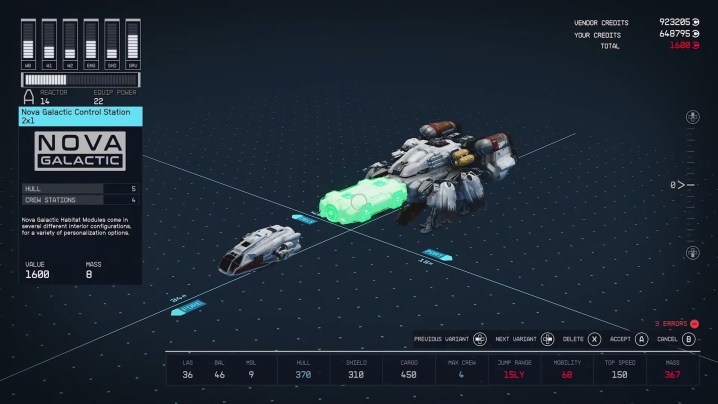
Though the massive space sandbox can feel lonely and uneven, there’s an important reality to consider that goes beyond what’s actually included in the base game. Bethesda titles live and die by their modding communities, who give the company’s titles decades of extra life with unbelievably creative tune-ups. I’m already picturing a future where empty worlds are populated with custom cities, where I can zoom around a moon’s craters on a land speeder, where Thomas the Tank Engine appears among the stars and tries to gun down my ship.
That utopian vision is far more poignant than anything Starfield actually says. The story itself is about humanity’s desire to explore the very limits of our universe. It’s only fitting that Bethesda presents players with an astonishingly massive expanse and invites them to poke and prod it in every way they can think of. A decade from now, I imagine Starfield will stand as a multiversal monument to human dedication and creativity. That’s just not the game I’m actually tasked with critiquing here.
The Bethesda experience
When reflecting on Starfield, I can’t help but think of the ambitious development team behind it. It’s apparent that this is a true passion project for Bethesda, which has spent the last eight years looking to create the biggest, most groundbreaking video game possible. It’s an impressive work of craftsmanship that I can’t help but admire … though it’s probably no surprise to hear that it comes with some traditional Bethesda caveats.
Though it’s likely less buggy than the studio’s previous games have been at launch, that’s like applauding a five-star chef for not serving too much raw steak in one night. Starfield is full of glitches that range from inoffensive (jittery corpses) to game-breaking (quest-locking bugs) to downright weird (my character losing her face skin, turning her into a floating pair of eyeballs). Some of its more glaring issues I experienced may be addressed with early patches, but I can feel how close the game is to collapsing in on itself. During my playthrough, an entire hub city broke entirely, with every NPC losing their torsos and turning into a pile of floating limbs.
Elements that would have been groundbreaking even four years ago feel dated today.
Even if those more obvious bugs get cleaned up, Starfield has some notable performance issues to contend with on Xbox Series X. Whenever I freely run across a planet’s surface, the frame rate tends to stutter or downright tank depending on how busy the environment is. Chaotic story set pieces run into the same stability issues, with lots of jitters when it matters most. The impressive scale comes with visual inconsistency too. There’s a gulf of quality between breathtaking space vistas and flatly lit, sparsely detailed city rooms.
Starfield’s greatest hurdle, though, is a philosophical one. Bethesda set out to make the definitive outer space game when it began developing the project in 2015, but eight years is a lifetime in the rapid world of video games. Like the universe, the game industry is always expanding. Elements that would have been groundbreaking even four years ago feel dated today. The standout writing of The Outer Worlds, Star Wars Squadrons’ astonishing dogfights, even Cyberpunk 2077’s intricately designed Night City — all of these feel light-years ahead of Starfield when breaking it into its individual elements.
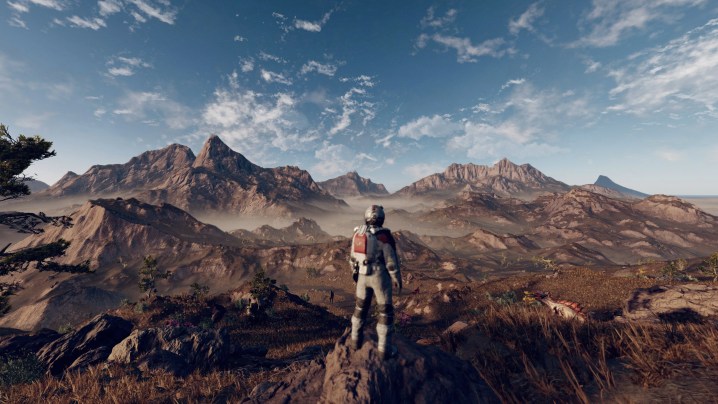
Even with this laundry list of critiques, I’m still surprised to say that I find myself in awe of Starfield. And to understand why, I once again return to Constellation and the Sisyphean task on its hands. The group operates with tireless conviction in the face of infinity. That’s also the case with the developers at Bethesda as they continue to chase their own distant dream. Starfield is imperfect, but it’s through those imperfections that it delivers its most inadvertently honest takeaway. It’s a testament to human spirit and all the messy, beautiful things that are possible when we’re determined enough to reach for the stars.
Midway through my story, I strike up a conversation with a companion about Constellation’s goals. We discuss what drives them to seek the impossible, knowing full well they’ll never see the edges of space while remaining undeterred in the face of that maddening truth.
“The noble quest of discovery,” she replies.
Starfield was reviewed on a Xbox Series X hooked up to a TCL 6-Series R635.
Editors' Recommendations
- Best Xbox Game Pass deals: Upgrade to Game Pass Ultimate for cheap
- The best external hard drives for Xbox Series X
- Fallout 4 is finally getting free Xbox Series X and PS5 upgrades
- The best games on Xbox Game Pass for right now (April 2024)
- All upcoming Xbox Series X games: 2024 and beyond


